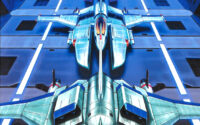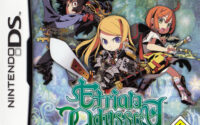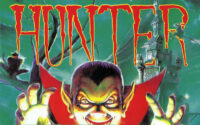R-Type DX Review

The ultimate R-Type challenge for Game Boy Color.
Story
The Bydo Empire and its extra terrestrial mutants are preparing for an attack on Earth. A lone R-Type fighter ship is sent to penetrate the Empire’s defenses and strike a blow against the evil master minds behind this wanton onslaught on humanity.
Locate their secret bases and destroy all evil, before the Bydo Empire destroys us all!
The Game
R-Type DX is a great R-Type collection exclusively for Game Boy Color. It features the original Game Boy versions of R-Type and R-Type II as well as the Game Boy Color enhanced versions of those games. As an added bonus there is also R-Type DX, which basically is both R-Type games added together to form the ultimate marathon challenge.
R-Type is a legend when it comes to horizontally scrolling arcade shoot ’em ups. For those who are not familiar already, R-Type is originally an arcade game from 1987 and it became a great success due to its crisp graphics, inspiring art direction and perhaps most of all its innovative power-up mechanics. Furthermore, the game is known to be a real hardcore challenge where you need super fast reflexes, precision controls and meticulous memorization to avoid all the dangers as you keep blasting the oncoming enemies.
The Game Boy ports of the R-Type games are obviously scaled down both graphics and sound wise, but the change that has the biggest impact on the gameplay is the smaller screen. There’s less room to move around on, which makes things a little more cramped and there’s also fewer enemies. Another game changing difference here is that in the Game Boy version of R-Type II you can shoot enemy bullets out of the air. This was not possible in the arcade original.
Overall the game is very straight forward like an arcade shooter should be. You control a space ship called R-9a Arrowhead and your mission is to eliminate the bosses at the end of each stage. Getting to the bosses will require you to blast waves of enemy fighters, robots and huge evil machines.
Controls
The standard controls work just great. You can move around, shoot, charge your Beam shot, attach and detach the Pod exactly like in the arcade original. The Pod is a key power-up in R-Type games. It can either fly freely and give support fire, or it can be attached to your ship where it instead assumes the role of a shield that can block most enemy bullets. However, in these Game Boy versions of R-Type the Pod behaves really strange. It has a tendency to get stuck in walls and on the edges of the screens. When this happens you have no choice but to call the Pod back. If you are in a cramped area, this can force you to attach the Pod on the wrong end of your ship. This in turn can cost you a life!
Before the game begins you can opt for one of the auto shot options. These will give you rapid fire functionality, but at the expense of either moving the Pod control to the Select button, or making the B button a hybrid between rapid fire shots and charging the Beam. The former works better in our opinion as the latter introduces a short delay before you can start charging the Beam. We prefer to not use any auto shot options, as that is more true to the arcade experience.
Content
The first R-Type features six stages of pure madness. Here you’ll fight crab-like aliens, attack drones of all sorts, robots and gun turrets. You’ll navigate the Bydo Empire headquarters, weird alien infested underground bases and a robot factory.
R-Type II features five levels, which deliver more of the same. More aliens, robots and monsters to destroy in even more exotic environments; there’s flooded caves, open air battles, another base belonging to the Bydo Empire and a forest stage.
Both games play basically the same. You have the same type of weapons options, power-ups and Pod functionality. You die from one single hit, and touching anything in the background will instantly kill you.
The big difference in R-Type II is that you can overcharge your Beam to unleash a huge burst of mass destruction. This takes a while to charge up so you’ll have to use it wisely. When timed just right, it can wipe out entire waves of enemies. It also causes huge damage to bosses.
There are three different weapon power-ups you can collect, and an upgrade to every each one of them. The Laser upgrade is a long laser beam that bounces off of surfaces, the Bubble Unit uses double rings of lasers and is the most powerful weapon against enemies straight in front of you. Finally, the Fire Chain releases flame like beams vertically to take out ground units.
When you are fully powered up the Pod offers a very powerful four-way shot when it is detached from the ship.
There’s also sub-weapons like homing missiles and air-to-ground bombs, but these are relatively rare. Speaking of rare power-ups, a few times throughout each game you’ll find the Plasmo. This is a smaller external Pod that protects your ship. It blocks enemy bullets, destroys enemies on touch and is extremely helpful in some situations.
As mentioned, the controlling the Pod is a key part of the game. You can use the Pod in many ways, as any enemy that touches it takes damage. You can send it into enemies, which will often destroy them instantly. This can also cause huge damage to bosses. There’s also occasions when you really need the Pod to act as a shield, so constantly adapting to the situation is part of what makes R-Type so great.
I find the Game Boy versions of R-Type to be a notch easier comparing to the arcade versions, probably due to the fact that the Game Boy does not support the same number of sprites on screen at the same time – the enemy waves have been reduced. But that is not to say that these games are easy – far from it. You have the option to play on three different difficulty levels in each game, even though we didn’t notice much difference between them.
When you die, you are taken back to a check point earlier in the stage, with all power-ups removed. You are given infinite continues, so you can keep playing for as long as you want.
Furthermore, the game has high score tables and for each play session is shows stats on your shots fired, accuracy, number of enemies destroyed, ships lost and continues used.
As an added bonus, you can also select starting stage, granted that you have unlocked those stages earlier.
Graphics
The Game Boy isn’t exactly well suited for these kind of games. Shoot ’em ups generally tend to have many sprites on the screen at one time, and the frame rate can do all the difference between life and death. R-Type is by no means an exception. The amount of bullets and enemies on screen will push the hardware limitations and when that happens, the sprites will immediately start to flicker and even disappear completely. This is quite annoying, but it usually isn’t bad enough to disrupt the game play experience. I think they have made the right balance between performance and graphics on this one. Otherwise the game looks pretty good with lots of detail and smooth animations.
Sound
The music is kind of faithful to the arcade original, but these Game Boy versions of the songs aren’t exactly pleasing to the ears. The music sounds eerie, out of tune and extremely noisy. In a way it fits the game – it certainly sets the mood, but it isn’t that great to listen to in the long run. What’s more, it is constantly interrupted by the sound effects. This is of course a disruptive, but at least the developers where so thoughtful that they gave us the option to turn off sound effects and music independently from the options menu.
Summary
R-Type DX presents a novel idea – a double feature R-Type feast with some extra options not seen in the series before. If you’re in the mood for some classic arcade shooting on the go, you can’t really go wrong with this one. It’s a real challenge, even if it doesn’t emulate the arcade originals exactly, and playing both games back to back allows for some score challenges not previously possible.











